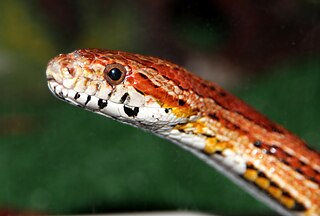
The corn snake is a species of North American rat snake in the family Colubridae. The species subdues its small prey by constriction. It is found throughout the southeastern and central United States. Though superficially resembling the venomous copperhead and often killed as a result of this mistaken identity, the corn snake lacks functional venom and is harmless. The corn snake is beneficial to humans because it helps to control populations of wild rodent pests that damage crops and spread disease.

Pantherophis obsoletus, also known commonly as the western rat snake, black rat snake, pilot black snake, or simply black snake, is a nonvenomous species of snake in the family Colubridae. The species is native to central North America. There are no subspecies that are recognized as being valid. Its color variations include the Texas rat snake. Along with other snakes of the eastern United States, like the eastern indigo snake and the eastern racer, it is called “black snake”.

Elaphe is a genus of snakes in the family Colubridae. Elaphe is one of the main genera of the rat snakes, which are found in many regions of the northern hemisphere. Elaphe species are medium to large constrictors by nature. Although all of the species in Elaphe are nonvenomous, bites from rat snakes are still irritably painful and can potentially cause bacterial infections, especially due to the saliva.

Pantherophis is a genus of nonvenomous colubrid snakes endemic to central and eastern regions of North America. It consists of the North American ratsnakes, the foxsnakes, and the cornsnakes. The genus, which contains 10 recognized species, first appeared in the fossil record in the Middle Miocene around 16.3 million years ago. They are a large terrestrial snake genus that lack subocular scales. Originally classified in the genus Elaphe, phylogenetic studies have found this taxon to be closely related to Pituophis. As with all snakes Pantherophis is an obligate faunivore with a diet that consists of small mammals, birds, reptiles and amphibians, and even insects. While many species conservation status is categorized as "least concern", many local populations in some species have declined where some places have them listed as federally protected. The corn snake is a popular pet reptile, due to the availability of captive-bred animals, their low maintenance and calm disposition, and the variety of color morphs. There are other species of Pantherophis that are in the pet trade, though are not as popular as the corn snake.

The common trinket snake is a nonvenomous constrictor species of colubrid snake native to south Central Asia.

Oreocryptophis porphyraceus is a rat snake species, commonly called the black-banded trinket snake, red bamboo snake, Thai bamboo rat snake or red mountain racer, found in mid to upper-level elevations of forested hills in southeastern Asia, ranging from evergreen tropical to dry seasonal forests depending on the subspecies and locality. It is the only member of the genus Oreocryptophis, but it was formerly placed in Elaphe.
The eastern trinket snake is a species of snake in the family Colubridae. The species is endemic to South Asia.
Elaphe hodgsoni, the Hodgson's rat snake, is a species of snake in the family Colubridae. The species is found in parts of Asia around the Himalayas.

Pantherophis vulpinus, commonly known as the foxsnake or the eastern fox snake, is a species of nonvenomous rat snake in the family Colubridae. The species is native to North America.

Pantherophis vulpinus, commonly known as the eastern foxsnake or eastern fox snake, is a species of rat snake in the family Colubridae. The species is nonvenomous and is endemic to the eastern Great Lakes region of the United States, as well as adjacent western Ontario in Canada. Pantherophis gloydi is sometimes considered a distinct species and sometimes considered a junior synonym of the species Pantherophis vulpinus.

The Trans-Pecos rat snake or Davis Mountain rat snake, is a species of medium to large, nonvenomous rat snake in the family Colubridae. Bogertophis subocularis is endemic to the Chihuahuan Desert.

Pantherophis emoryi, commonly known as the Great Plains rat snake, is a species of nonvenomous rat snake in the family Colubridae. The species is native to the central part of the United States, from Missouri to Nebraska, to Colorado, south to Texas, and into northern Mexico.

Pantherophis bairdi is a species of harmless snake in the family Colubridae. The species is native to the southwestern United States and adjacent northeastern Mexico. No subspecies are recognized as being valid.

The Japanese rat snake is a medium-sized colubrid snake found throughout the Japanese archipelago as well as on the Russian-administered Kunashir Island. In Japanese it is known as the aodaishō or "blue general". It is non-venomous. It is hunted by eagles and tanukis.

Elaphe schrenckii is a species of nonvenomous snake in the family Colubridae. The species is indigenous to Northeast Asia.

Euprepiophis conspicillata, commonly known as the Japanese forest rat snake, is a species of nonvenomous colubrid snake endemic to Japan. Its Japanese common name, jimuguri, roughly translates to "the burrower". It is closely related to Euprepiophis mandarinus, the Mandarin rat snake.

Elaphe quadrivirgata, commonly known as the Japanese four-lined ratsnake or the Japanese striped snake, is a species of non-venomous colubrid snake native to Japan.

Euprepiophis is a genus of nonvenomous colubrid snakes, containing three species of Asian rat snakes which were formerly assigned to the genus Elaphe. They were separated from Elaphe in 2002 by Utiger et al. following evidence from DNA analysis. They are true rat snakes but are not as closely related to other European, Asian, or North American rat snakes as their former place in Elaphe might suggest.

Senticolis is a genus of nonvenomous snake in the family Colubridae. The genus Senticolis is monotypic, containing the sole species Senticolis triaspis, also known as the green rat snake. The species is endemic to Central America, Mexico, southern Arizona, and southern New Mexico.
Elaphe davidi is a species of snake in the family Colubridae. The species is endemic to East Asia.
















